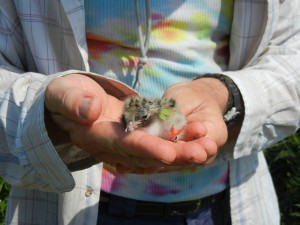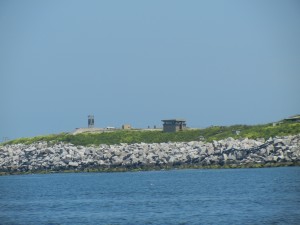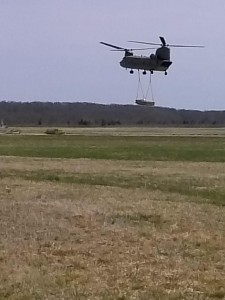

If you are anywhere near the Groton shoreline on Friday April 25, 2014, you may see an unusual site. The Connecticut Army National Guard will airlift 28,000 pounds of lumber and equipment out to Great Gull Island (GGI) in Long Island Sound. Great Gull Island, owned by the American Museum of Natural History (AMNH), provides nesting habitat for over 9,500 pairs of Common Terns and 1,500 pairs of Roseate Terns. This represents the largest concentration of nesting Common Terns in the world, and the largest concentration of nesting Roseate Terns in the Western Hemisphere. See the WTNH video of the airlift!

Great Gull Island, 17 acres in size, is the site of a former army fort with crumbling battlements and boulders surrounding the edges of the island. The Common Terns use the interior island, while the Roseate Terns nest in the boulders. Vegetation, including many invasive plant species, has overtaken parts of the island causing loss of nesting habitat. Connecticut Sea Grant, CLEAR, and US Fish and Wildlife Service are working with the AMNH to develop and implement a habitat management plan for this island.
Superstorm Sandy destroyed the recently completed dock at GGI making travel to and from the Island difficult enough for people let alone getting supplies out there. Helen Hays is the manager of the Great Gull Island project and has worked on the Island since 1969, monitoring, banding and counting the bird populations. Hays noted that the Storm overwashed parts of the island forcing the birds to look for and move to other areas for nesting.
The Connecticut Army National Guard will use a CH-47 medium-lift Chinook helicopter to transport 28,000 pounds of lumber out to the Island. The lumber, purchased with grants from the USFWS and the Long Island Sound Futures Fund, will be used to build bird blinds and terraced nest boxes for tern nesting. The blinds are used to observe the birds and the nest boxes will increase nesting area for the terns.
Volunteers will help load the lumber at the Groton-New London Airport and volunteers on the island will unload, and others will start building blinds and terrace boxes in preparation for the return of the terns around April 27th.
See first-hand video of the airlift from Groton Airport:
http://www.youtube.com/watch?v=KdTPTyIqHng